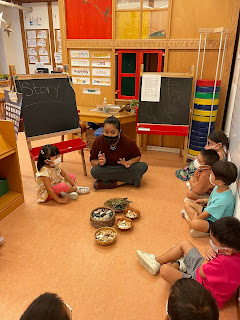6: On Creativity, Loose Parts, and Being Kind
“Loose parts require the hand and mind to work in concert, they are catalysts to inquiry.”
Loose parts are materials that have been around for a long time — ever since children learned how to play with rocks, sticks, and other random materials that they can get their hands on.
In 1971, an architect named Simon Nicholson studied this approach and formulated a theory, aptly named the Theory of Loose Parts. He believes that all children are creative and that they should be given the opportunity to nurture this gift. Presenting them with loose parts — open-ended materials — rather than “finished” materials or toys can help stimulate their imagination and empower their creativity. These materials also foster inquiry and promote learning.
In the center of our Kindergarten classroom I’ve prepared a loose parts table that the children use for different purposes: to create art, to play with, and to tell stories with. The past few weeks, they’ve used it for cooking “food”, creating their self-portraits, counting, and even for keeping track of their kind deeds!
This week, loose parts played a big role in Kinder 2’s learning as I used it as a tool for reviewing the alphabet and for storytelling.
We started off the week with a book called “If Rocks Could Sing: A Discovered Alphabet” by Leslie McGuirk. After reading the book, the children agreed that we can find the alphabet everywhere. This paved the way for our week-long letter hunt in school and in the green field. The children took the book with them everywhere, until we finally completed a set of rocks for our alphabet display. They all decided together what piece of rock to use for each letter, and are proud of the alphabet that we’ve collected.
In our quest to find the alphabet, we also found other loose parts — such as sticks and leaves — that we used for our story workshop this week. The children even found mounds of sand and soil to play with! They definitely got their hands and feet dirty on this mini-adventure.
Since we have been talking about our first food group — fruits and vegetables — I think it’s a wonderful opportunity for the children to share their favorite personal stories that involve these. I started off by sharing my personal story of how a fruit strengthened the friendship of my students many years ago. I used loose parts to tell my story by creating an image as I shared each part.
Of course, the children had an opportunity to share their stories, too. Here are some of their personal stories:
I think the children’s stories are a testament that everyone has a creative side, we just need to give them the opportunity to unleash it. Do you agree with me? 😊
To deepen the children’s understanding of our lesson on fruits and vegetables, I’ve given the Kindergarteners the opportunity to investigate the food that we have on display (thank you for your contributions last week!) We had an interactive “cooking” demonstration where all the children participated in describing the characteristics of the fruits and vegetables on the table. They shared their enthusiasm and excitement everytime we sliced a new fruit or vegetable. Some of the children revealed that they haven’t tried a few of the food items that we investigated, and are eager to taste them in the future. One chlid really wanted to eat the raw pumpkin — but I told her that it’s better to cook it first! I did read that it’s possible to eat it uncooked, as a snack. Have you ever tried that before? :)
For art this week, I introduced the students to an artist whose work I truly admire: Henri Matisse. In the latter part of his life, he created collages using cut out paper. I showed some of his work to the children, as well as art inspired by him. We tried his technique and created a collage of fruits and vegetables that the children learned in class. What the children came up with is a beautiful addition to our display!
This week, we also continued inquiring on the concept of choice. This time, I used it as an opportunity for the children to reflect on their choices and how they affect other people. I read a book called “What Does It Mean to Be Kind?” by Rana DiOrio, which highlights different acts of kindness that we can share with other people. We placed the book beside one of the stories that we read in the past, “David Goes to School,” and compared the choices of the characters. I used this opportunity to unlock two new words: Acceptable (Good) and Unacceptable (Not good. I particularly avoided using the word “bad” so as not to encourage the children to label people with this word based on the choices they make.)
The children came up with a list of actions that fall under each category, and we kept on adding to the list throughout the week.
Have a wonderful long weekend to all of you!
Your Kindergarten teacher,
Pam
P.S. Did you notice anything new with our class?
Diego’s back and we’re all very happy!























































Comments
Post a Comment